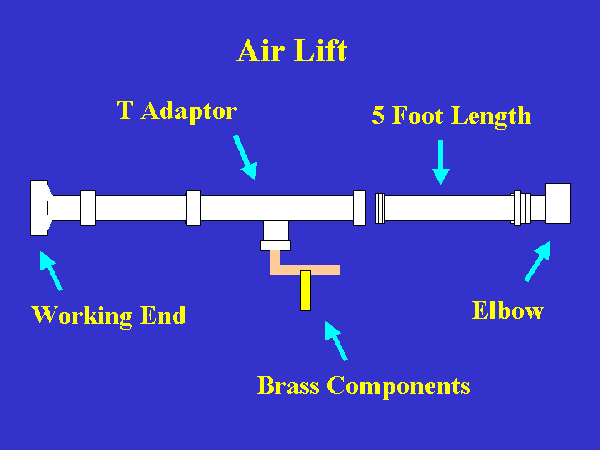
by
Larry "Harris" Taylor, Ph.D.
This is an electronic reprint of an article that appeared in Sources (Sept/Oct. 1991, p. 41,42,& 46). This material is copyrighted and all rights retained by the author. This article is made available as a service to the diving community by the author. This article may be distributed for any non-commercial or Not-For-Profit use.
All rights reserved.
Go To: Home About Articles Slides War Stories Editorials Links Fini
One of the major differences between "Divers" and "C-Card Holders" is the ability of divers to "do things" underwater. In training, it is often not necessary to complete useful labor, but giving students a tool to utilize, as well as an accomplishable goal, increases student enjoyment and learning. Among the devices my students use in search and recovery exercises is the air lift. This device will not rapidly move mountains, but it does provide an enjoyable learning experience. In addition, students will be pleasantly surprised at the amount of material this simple device can move.
The device is assembled from standard 2" PVC pipe (smaller than commercial or research tools ... small enough to provide an element of control while learning and to have a useable duration from a single scuba cylinder, but large enough to move a significant amount of material) and 1/2 " brass parts. These parts (list below) are readily available from a well-stocked hardware store. The total cost was less than $ 70 (1990 prices, when the device was assembled). The brass portion is universal and can be used for any size PVC pipe.

Assembly Hints
The use of threaded (male-female pairs) adaptors to assemble the PVC pipe pieces, as opposed to push-to-fit connectors, increases the total cost of the unit, but the stability of assembly, especially while being moved underwater, is worth the extra expense. The brass pipe threads, prior to assembly, are wrapped with Teflon tape to provide a better gas-tight seal. If gas leaks occur after assembly, then aquarium sealant can be applied at the brass pipe connections. A good student working length of the entire assembly is 10-20 feet of PVC tubing above the inlet adaptor. This provides adequate lift (the longer the tube, the greater the expansion, and the better the tool will operate) while providing some measure of control. The brass on/off valve should be large enough to be easily manipulated with gloves or mittens. (Gloves should be worn for abrasion protection, as well as any thermal protection needs). A optional 90o elbow at the end of the device helps diverts effluent away from the work site. A larger adaptor at the "working end" of the device helps protect the PVC pipe and provide a scoop to assist operation (see photos below). If the larger "working end" piece is NOT used, then a female PVC connector at the opening helps protect the end-piece of PVC (see PVC parts diagram, below ), The device is easily transported unassembled and put together on-site. (Assembly underwater is another exercise I use in developing in-water work skills and task oriented cooperation with fellow divers ).
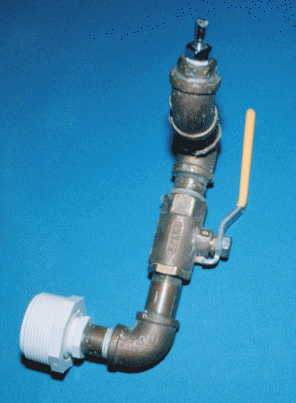
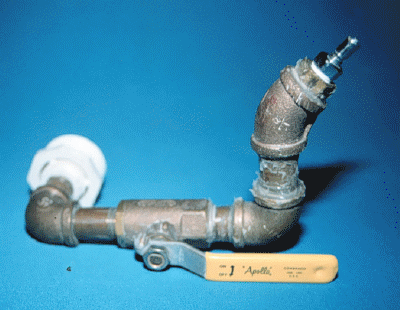
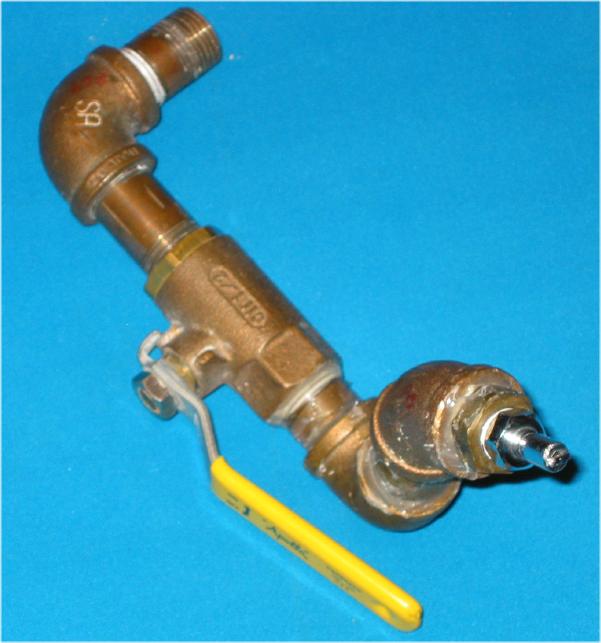
Three Views of The Brass Valve Assembly
Air Source
For 2" or smaller PVC pipe, a standard scuba cylinder can be used. The cylinder is mounted in a standard backpack (with all the straps removed to allow a large hand-hold on both sides of the backpack). This allows two students to carry the cylinder between them while swimming to the work site. After on-site assembly of the air lift, the scuba cylinder can be attached to the device using a standard scuba quick-connect fitting. (A description of the regulator is found in my article Liftbags & Life. It is important to remember that the air supply on-off valve used of the air lift is NOT of the downstream variety typically found in second stages, so that a regulator (or larger air supply) failure could possibly lead to an over-pressure event. Thus, it is necessary that the first stage of any scuba regulator (or any air source) used has an over-pressure relief valve between the air source and the on-off valve of the air lift.
Using a standard scuba 72 cubic foot cylinder at 10-15 feet of depth in 50 oF water, the device consumes about 1000 psig in ten minutes. Obviously, deeper depths will consume air at a faster rate. Working depths are typically deeper, and eventually scuba cylinders become too cumbersome and short-lived to be useful. For working applications, surface supplied gas (either larger storage bottles or a compressor) are needed. There are other types of standard quick-connect fittings that allow this air lift assembly to be connected to larger sources of air.
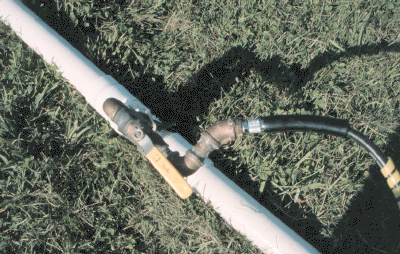
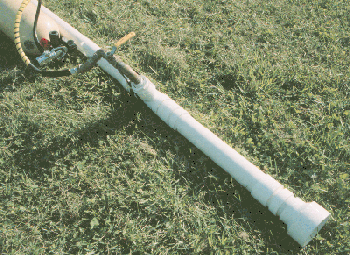
The Air Lift Connected To Scuba Cylinder
Using The Device
This device is divided into modules with a person assigned to each unit. The units are:
Scuba cylinder with regulator attached: carried by two divers using the hand-holds of the back plate
Brass components with the PVC T-adaptor with "working" end components
Lengths of PVC pipe, secured together with a Velcro tie at each end (elbow, if used, attached to last section)
Alternatively, in a two person operation, all the components can be secured to the back plate holding the scuba cylinder. The cylinder is best carried between two divers.
Students discuss and plan the operation on the surface prior to deployment.
The components are assembled on-site underwater. Although the elbow will divert effluent, typically, lifted debris will "rain" on the work site and visibility can be dramatically reduced. In a "working" situation this can be avoided by adding flexible tubing (like used on a dryer) to the elbow at the end of the tube. This effluent can be directed onto a screen grid above the surface of the water and "valuables" removed from the emerging air-water stream.
The device is best used in a two handed operation. One hand on the on/off valve and the other on the tube for support. The most vulnerable portion of this device is the brass/plastic junction and divers must take care not to over-stress this area. One method to help stabilize this area is to use two short lengths of Velcro strap to fix the position of the brass assembly in a position parallel to the length of PVC pipe. As soon as air flow is initiated, the device will move into a vertical position. It will be difficult to move the air lift into anything other than a vertical alignment.
Caution: It was demonstrated in the late 1970's by a University of Rhode Island study on scuba cylinder corrosion that pressing the purge valve of a scuba regulator in a pool at low cylinder pressures could result in the influx of substantial amounts of water into the scuba cylinder. For this reason, it is perhaps prudent NOT to completely empty the air source, but to terminate the operation with several hundred psig remaining. Cylinders which have been totally emptied should be VIP' ed before refilling with air.
In general, students do NOT find massive amounts of gold bars in our Michigan muck, but using this device does provide a sense of accomplishment and an understanding of how such devices can be used. In addition, the principles and acquired skills can be applied to any size diameter pipe.

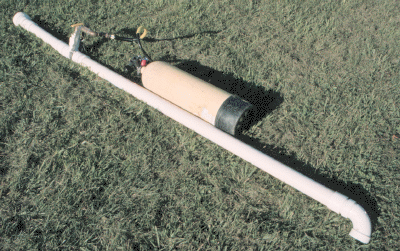
Air Lift with 1 and 3 5' PVC Lengths
Parts List

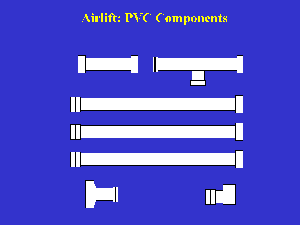
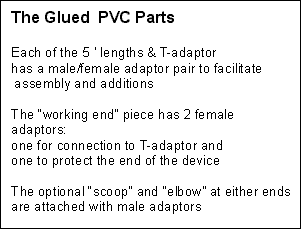
Acknowledgement
The airlift device described in this article is a scaled-down, modified-for-training version of a commercial air lift used by Charles Craw in his business and orientation to commercial diving class. The author thanks Charles not only for the inspiration to build this search-and-recovery-class-training-aid, but also for his awesome commercial orientation class, and all the encores we requested. Photography and graphics by the author.
Brady, E. Marine Salvage Operations, Cornell Maritime Press, Cambridge, MD. 1960, 81-84.
Lockery, A. Marine Archeology and the Diver, Atlantis
Publishing, Toronto, Ontario, Canada, 1985, 38-39.
Malatich, J. & Tucker, J. Tricks of the Trade for
Divers, Cornell, Maritime Press, Centreville, MD. 1986, 46-48, 93, 101.
Marx, R. The Underwater Dig, Pieces Books, Houston,
TX. 1990, 32, 34, 65, 67, 97, 135-138, 144, 167.
Miller, J. *Ed.) NOAA Diving Manual, 2nd.
US Government Printing Office, Washington, DC. 1979, 4-31, 8-41-43.
Reid, G. Boatman's Guide To Light Salvage, Cornell
Maritime Press, 1979, 57-58.
Go To: Home About Articles Slides War Stories Editorials Links Fini
About
The Author:
Larry "Harris" Taylor, Ph.D. is a biochemist and Diving Safety Coordinator at the University of Michigan. He has authored more than 200 scuba related articles. His personal dive library (See Alert Diver, Mar/Apr, 1997, p. 54) is considered one of the best recreational sources of information In North America.
All rights reserved.
Use of these articles for personal or organizational profit is specifically denied.
These articles may be used for not-for-profit diving education